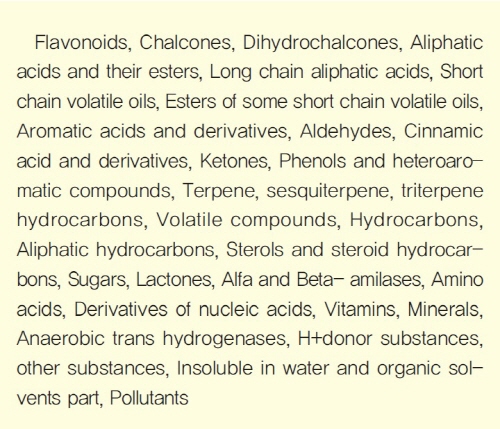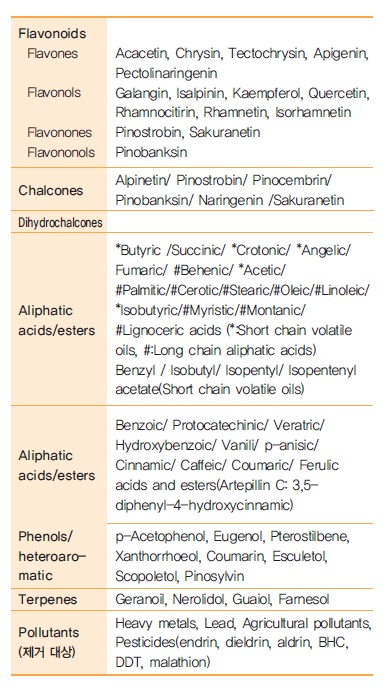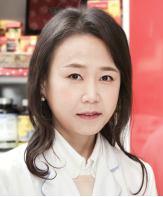수종 같다면 제품의 특징은 종류 아닌 함량이 결정
300가지 성분분석서 중요, ‘생화학적 구성’이해해야
프로폴리스는 수많은 건강상 이익들을 줄 수 있기에, 현재 수준보다 더욱 다양한 의학적 영역들에 적용되어야 한다고 본다. 최근 약 50년간 이루어진 많은 연구들에 의해 증명된 결과들에 의하면 충분히 그렇다는 것이다.
프로폴리스는 외형상 왁스 같은 밀도의 수지성 물질로서 벌이 주로 나무의 싹이나 껍질로부터 채취하여 만들어진다. 프로폴리스의 색, 구성성분, 물리적 특성들은 다양한데 물론, 이는 매우 복잡한 구성성분들에 의해 표현된다. 그래서 어떻게 프로폴리스가 우리에게 유용한지 알아내기 위해서는 무엇보다도 그 생화학적 구성성분들을 이해해야 한다.
Greenaway등은 1990년 발표한 리포트에서, 서로 다른 포플러(poplar)종의 수목으로부터 벌이 수확한 물질들은 정성적인 구성은 서로 비슷하나, 정량적인 구성은 매우 다를 수 있다고 하였다. 즉, 각 생산 지역 포플러 수종 근원 프로폴리스 제품들의 특징은 성분들의 종류가 아니라 함량의 차이가 결정한다. 단 프로폴리스의 근원 수종이 크게 포플러(poplar)종과 바카리스(baccharis)종으로 분류되는데, 각각의 수종 안에서 말이다.

다시 말하면, 포플러종과 바카리스종 근원 프로폴리스의 생화학적 구성성분은 아예 서로 종류가 다르고, 같은 수종 내에서는 종류는 같으나 각 성분의 함량이 다르다는 뜻이다.
이번 글에서는 포플러 수종 근원 프로폴리스들의 분석자료를 살펴보기로 하고, 브라질 등 중남미 지역을 대표하는 바카리스 수종 근원 프로폴리스들에 대해서는 다른 글로 소개할 예정이다.
이들에 의하면, 대체로 프로폴리스는 수지와 발삼 55%, 왁스 7.5~35%, 정유 10%, 화분 5%, 지방산 5%, 불순물 4.4~19%, 기타 terpenes, tannin substances, 벌의 침 성분 등으로 구성되어 있다고 했다.
다양한 프로폴리스 각 성분의 종류들이 그동안 진행되어 온 수많은 실험연구들을 통해 밝혀졌으며, 벌이 수목에서 채취한 프로폴리스의 근원이 되는 물질의 내용이 식물 삼출물 성분 내용과 동일하다는 것을 증명할 수 있었다.
즉, 대부분의 식물 삼출물(주로 수목의 싹에서 분비되는 물질) 구성성분들이, 특히 몇몇 glycosides의 벌의 타액에 의한 효소적 가수분해 가능성과 왁스의 혼입에도 불구하고 변동 없이 그대로 프로폴리스에 존재한다는 것이다.
1987년Walker와 Crane이라는 사람들에 의하면,
▶ 각 성분들은 하나 또는 그 이상의 식물 수종으로부터 유래한 하나 또는 그 이상의 서로 다른 프로폴리스들에 존재한다.
▶ 몇몇 성분들은 모든 프로폴리스들에 공통적으로 존재한다.
▶ 몇몇 성분들은 특정 수목의 수종에서만 채취해서 만들어진 프로폴리스에만 존재한다.
라고 하였다.
프로폴리스의 약리학적 활성을 나타내는 성분들은 에탄올 등과 같은 용매로 추출된 분획들에서 찾아낼 수 있다. 해당 리포트에서는 서로 다른 프로폴리스들에서 약 300가지 이상의 성분들이 보고되었으며, 각 성분들의 생화학적 상위 클래스들을 정리해보면 다음과 같다. 물론 아직 밝혀지지 않은 성분들이 매우 많을 것으로 보고 있다.

이중 가장 중요한 것은 flavonoids에 속하는 flavones, flavonols, flavanones와 다양한 phenolics, aromatics이다.

프로폴리스의 약리학적 활성은 약 60여가지 이상으로 분석되고 있다.
activate the macrophages, induce the cytokine and inhibit the growth of tumor cells (large intestine), agglutinant effect, anti-allergy, anti-acid resistant micro-organisms, anti-bacterial, antibiotic, anti-blastomycetes, anti-clavus, anti-depression/sadness/melancholy, anti-haemorrhage, antiherpetic, anti-infectious, disinfectant, anti-inflammatory, anti-leukemic cells, anti-microbially, anti-mold, anti-mycobacterium tuberoculosis, anti-mycotic, anti-edema, anti-oxidant, anti-parasites, antiproteolysis, antiseptic, anti-spastic, anti-sudorific, anti-sterss, anti-trichomonas, antiviral, balamic, cicatrization and regeneration of epitheliums and endotheliums, conservatives, decrease the desire to smoke, to drink alcohol, decrease high blood pressure, derease the high cholesterol level in the blood, decrease the high pressure of eyes(glaucoma), decrease the permeability of capillaries, decrease the capillaries fragility, deodorant, depurative, diminishes the gastric secretion by increasing the histaminopexic activity, diminishes the side-effects of chemo- and radio- therapy, energising, revitalising, tonic, external use, cleanses and softens the skin, eliminates the thorns, histaminopexic activity, hypocholeretic, immunomodulatory action, increases the resistance of the body to infectious diseases, intensifies the phagocytosis, local anaesthetic, mineral source, nutritive, phytoinhibitor, prevents and diminishes the acute pulmonary insufficiency, promotes build-up of collagen and elastin, pro-oxidant, protects the body against radiation, protects the body against negative bee venom effects, spasmolytic, stimulate mammalian tissue regeneration, stimulate mitosis and enhances protein biosynthesis, stimulates the cellular respiration, stimulates the cytocidal action of lymphocytes thus inhibiting the growth of tumor cells, stimulates the detoxification function of the body(liver), stimulate the regeneration of epitheliums, endotheliums and cell membranes, sunscreen agent
그럼 각 주요 성분들의 해당 약리학적 활성을 연결하여 보면 다음과 같다.
1. Flavonoids
- anti-microbial/ anti-inflammatory/ increase the activity of ascorbic acid and action on capillary vessels/ anti-oxidant/ decrease the permeability of capillaries/ stabilities the collagen through inhibiting the hyaluronidase/ anti-haemorrhage/ influence in vitro of some flavonoids on the enzymatic metabolism of mucopolysaccharides from saphenous veins
2. Chysine
- Gives the color of beewax/ tumor cytotoxicity/ anti-helicobacter pylori
3. Apigenin
- Healing of gastric ulcer
4. Quercetin
- Histaminopexic activity/ anti-viral/ strengthening capillaries/ anti-tumoral/ spasmolytic
5. Kaempferide
- Anti-mycotic/ anti-acid resistant micro-organisms/ spasmolytic
6. Galangin
- Bacteriostatic activity/ anti-mold/ anti-blastomycetes/ anti-microbial/ anti-mycotic/ anti-candida/ anti-helicobacter pyroli/ local anaesthetic
7. Flavan-3-ols/ 3,4-dihydroxyflavanoids
- Strengthening capllaries
8. Pinobanksin
- Anti-microbial/ anti-mycotic
9. Pinostrobin
- Local anesthetic
10. Pectolinaringenin
- Spamolytic
11. Luteolin
- Antiviral/ healing of gastric ulcers
12. Artepillin C
- anti-tumor effet/ anti-leukemic effect
13. Eriodictyol
- Helping pulmonary insufficiency/ prevention of acute pulmonary insufficiency
14. Pinosylvin
- Anti-microbial(Bacillus subtilis)/ anti-mycotic(Mycobacterium phlei, M. Smegmatis)
15. Ferulic acid
- Anti-bacterial/ agglutinant effect/ collgenic effect/ promote build-up of collagen and elastin/ permeates propolis
16. Isoferulic acid
- Anti- Staphylococcus aureus
17. Isopentyl ferulate
- Anti-influenza virus A/Hong Kong (H3N2)/ inhibits the production of hemagglutinins
18. Cinnamic acid (its derivatives)
- Anti-Staphylococcus aureus(increase the cicatrization and the regeneration of epithelium)
19. Aromatic acids and their esters
- Anti-fungal/ anti-bacterial effect
20. Benzoic acid
- Bacteriostatic and bactericide effect/ Balsamic and antiseptic
21. p-Coumaric acid benzyl ester
- Anti-mirobial and anti-mycotic
22. Caffeic acid (its ester)
- Anti-viral/ anti-bacterial (gram +/-)/ anti-inflammatory(local anesthetic)
23. Caffeic acid phenethyl ester
- anti-tumoral activity
24. Methyl caffeate/ methyl feruleate
- Tumor cytotoxicity or inhibition
25. Diterpenoid of clerodan
- Anti-tumoral activity/ anti-bacterial
26. Pterostilbene
- Anti-diabetic
27. Volatile compounds
- Anti-tumor effect
그 외amino acid로서 arginine, proline 등이 있으며 소량의 vitamins와minerals가 다양하게 포함되어 있다.
각 프로폴리스 제품의 성분분석서를 받아야 하는 이유가 바로 이러한 품질의 고하 결정과 주요 기능 및 효과에 대한 이해 때문이다. 건강기능식품의 특성상 자세한 성분내역이 라벨 등에 표기되어 있지 않아 그 품질의 정당성 및 효과를 미리 예측 및 판단하기 쉽지 않기에 반드시 제품의 공급자 또는 제조사로부터 해당 제품의 원산지 원재료증명서와 제품 성분분석서를 확인하기 바란다.

다음 글에서는 이들 성분들이 복합적으로 작용하여 개선 및 치유에 기여하는 약 300여가지 증상 또는 질환에 대해 근거중심적으로 살펴보기로 한다.
<참고문헌>
1. Greenaway, W., Scaysbrook T., Whatley F.R. (1990) The composition and plant origins of propolis. A report of work at Oxford, in Bee World, 71(3), P. 107-18
2. Maciejewicz W., Daniewski M. Mielniczuk Z. (1984) Gas chromatography- mass spectrometry investigation of propolis Analysis of phenolic acids and sugars. In chemia analit, 29(2), P421-27
3. Budavari, S(1989) The Merck Index, Merck & Co.: Rahway, N.J.
4. Donadieu, Yves(1994) Un medicament natural essential: La Propolis (2), in Abeilles et Fleurs, #426, p5-6

